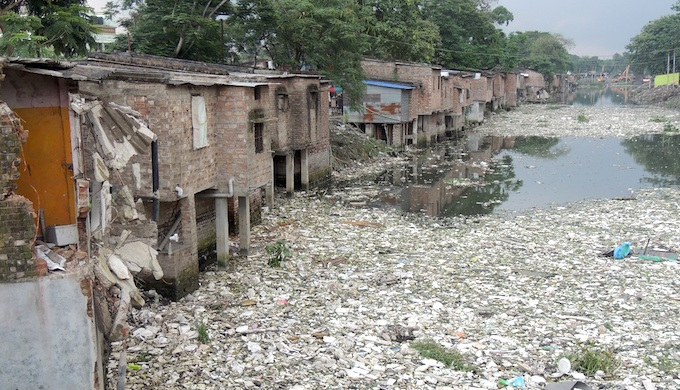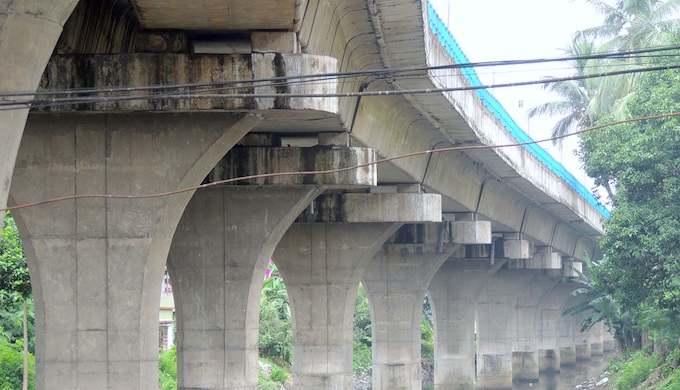Stretches of the original channel of the Ganga in West Bengal have been completely submerged under rubbish, illegal buildings and city metro tracks

This was once the main channel of the Ganga to the sea. (All photos by Jayanta Basu)
Adi Ganga, the nearly 75 km long original channel of the Ganga, has been hijacked at several places. Three centuries ago, this was the main outflow of the Ganga to the Bay of Bengal. Today it is a sewer buried under garbage and the Metro rail network, encroached upon, converted into personal ponds and homes.
The destruction of the Ganga has been most rapid in the past three decades, the period when nearly INR 200 crore (USD 30 million) has been pumped into its so-called restoration. There’s yet another project worth INR 600 crore on the anvil, with the World Bank talking about funding Kolkata Municipal Corporation for pollution abatement of the Adi Ganga under the National Ganga River Basin project. This project is behind schedule even before it has started.
The original Ganga
Historical texts and maps say the Adi (original) Ganga was the river’s main channel around the time Kolkata was established in the last decade of the 17th century and became a major port under the British Empire. It flowed (as the sewer does today) beside the famous Kalighat temple and then through Garia before ending up at Gangasagar, the confluence of Ganga with Bay of Bengal.
Around 1750, a canal was cut to connect the river Hooghly with the lower part of the river Saraswati near Sankrail in Howrah. That moved most of the water flow westwards, and the Hooghly became the main channel of the Ganga, as it is today.
In the 1770s, as the Adi Ganga started to recede, William Tolly supervised the dredging of a 15 km channel from Garia to Samukpota and connected the Adi Ganga to the Bidyadhari river, which flows to the sea through the Sundarbans. Even today, this stretch is called Tolly’s Nullah.
The river, which earlier flowed through Boral, Rajpur, Harinavi and Baruipur – towns on the edge of the Sundarbans – was increasingly choked. But even in the 1940s, it was good enough to transport goods through non-mechanised boats. “Even in my childhood (around 1940s), it was a quite a big river and was being regularly used for navigating goods,” wrote Rebati Ranjan Bhattacharya, the river crusader who fought for the resurrection of Adi Ganga till his last breath in 2005.
Others can remember that even in the early 1970s, honey gatherers from the Sundarbans brought honey and bamboo up the river in their boats, and tied up below the bridge that leads to Tollygunge, a busy suburb in south Kolkata.
Killed by people, killed by railway
Apart from being used as a rubbish dump, the story of the Adi Ganga, especially in and around Kolkata, is one of encroachment. In 1998, the West Bengal government acknowledged in a report to the High Court that in the 15.5 km stretch from Hastings (the confluence with the Hooghly) to Garia (where Tolly’s Nullah starts), there were 7,851 illegal structures with about 40,000 residents, 90 temples, 69 warehouses, 12 cattle sheds and others.

Illegal structures at the Kalighat stretch of the Adi Ganga.
On April 24, 1998, the Kolkata High Court ordered that all encroachments be removed within a month. They are still there, as a recent state government report admits. The West Bengal Pollution Control Board and Kolkata Municipal Corporation have also admitted gross encroachments within the Adi Ganga in their recent reports to the eastern bench of the National Green Tribunal.
“Such unhindered large-scale continuous encroachment is only possible because of local mafias being supported by political powers,” says activist Subhas Datta.
The six-kilometre expansion of the Metro rail from Tollygunge tram depot to Garia appears to have hit the last nail on the coffin in 2009. The 300-odd pillars supporting the rails rise from the middle of the channel. “There was a large public outcry and even a public interest petition was filed in High Court against the move, but nothing could be done as Metro rail got away showing a hundred years old norm which says that nothing can be done against a railway project,” observed Mohit Roy of Vasundhara, a non-profit.
Stinking river
Encroachments on the Adi Ganga is the norm rather than the exception. Concrete houses with foundations eating into the riverbanks have drains that release waste directly into the river. In addition to that, in the Kolkata stretch alone, there are thousands of shanties on both banks, with makeshift latrines right on top of the water. All this is regularly interspersed by cattle sheds, small factories and even neighbourhood recreation clubs along the banks. Discarded polythene packets flutter around Metro rail pillars and obscure the dark water wherever the water hyacinth does not do so. Nothing can obscure the stink.
Disappearing river
It gets worse beyond Garia. The river disappears.
For around three kilometres in Narendrapur and Rajpur-Sonarpur, there is no visible river. In its place, there are concrete houses, community halls and roads. Close by, there are a few elongated ponds whose names are a giveaway – “Karer Ganga” (Kar’s Ganga), “Ghosher Ganga”and so on.
An elderly resident who declined to identify himself said, “Once the river flow had choked and habitation grew in the area, large-scale encroachment began on the river bed. This has quickened since the 1980s.”Rajpur-Sonarpur is one of the fastest growing towns in West Bengal.
Reappearing river
The river resurfaces after its hijack. thethirdpole.net team tracked its then-southward flow till a point in Suryapur near Joynagar in south 24 Parganas district. Residents said this river joined the Piyali, which flows through the Sundarbans to join the Matla and flow into the sea.
There is some hope of resurrection, even for the stretch that has disappeared. “We have reason to believe that Adi Ganga is not dead and actually flows below the built-up areas,” said Swapan Ghosh, secretary of a committee looking after the upkeep of Karer Ganga. A few years back, when we were trying to clean up the pond, we found there was a continuous flow of water from below.”

The Kolkata Metro tracks run over the Adi Ganga.
Pradip Sikdar, a groundwater expert at the Indian Institute of Social welfare and Business Management, said this may well be true. “In an unconfined aquifer, the river water can merge with the water underground.”
Dead river
But there seems little hope that the garbage and encroachments that have killed the Adi Ganga will be tackled in any meaningful way. Talking about the nearly 200 crore rupees already spent in supposedly cleaning it, environmental activist Subhas Datta said, “It’s a major scam, it’s a story of systematically murdering the river with encroachment, effluent discharge and all kind of possible degradation, under the obvious patronage of political powers.” Dattahas recently petitioned the National Green Tribunal about the degradation of the Adi Ganga.
Biswajit Mukherjee, former chief law officer of West Bengal Pollution Control Board, agreed. “This is nothing but a scam,” he said. “Not only in case of Adi Ganga but for the entire Ganga; under Ganga Action Plan projects, so much money has been spent but virtually no improvement of Ganga has taken place. Unfortunately in our country, environmental scams and crimes are hardly pinpointed.”
Pollution control board data shows the dissolved oxygen level along most stretches of the Adi Ganga is zero, so no life can exist in it. The coliform bacteria count is between nine and 16 million per 100 millilitres of water. The national standard for water fit for bathing is 500 per 100 ml. Apart from the garbage, 57 drains containing untreated waste water flow into the Adi Ganga.
Reason for hope
Pollution control board chairman and noted hydrologist Kalyan Rudra feels the Adi Ganga should be restored as far as possible because it plays a very important role in drainage of its hinterland.
Activists Datta and Roy say the Adi Ganga can be brought back to life. “It is entirely possible if state and central governments take active interest in resurrecting the original end flow of the Ganga,” Datta said.“If they can spend hundreds of millions for various studies on the Ganga and so called beautification, why can’t they take appropriate measures to rejuvenate the old channel?”
“There are various global examples where old and buried channels [in the UK and US] have been restored to undo previous mistakes. Why can’t we replicate them?” asked Roy.
